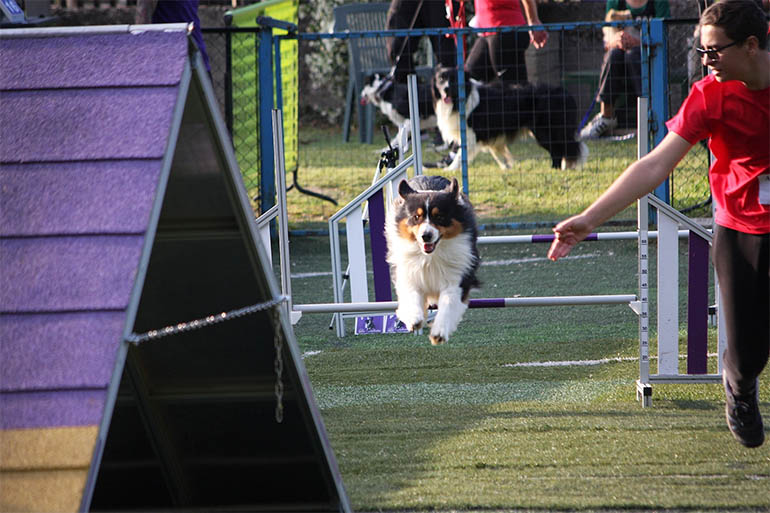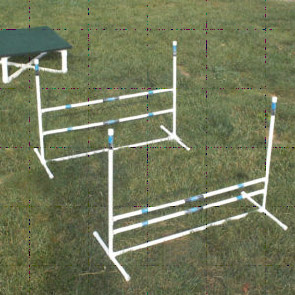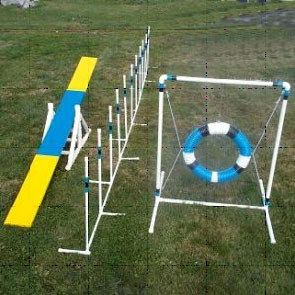
If you have a healthy, energetic dog, agility training can be a great option and your whole family can participate in the training and enjoy the excitement of competition. At Carlson Agility, we recommend jumping into agility with a dog agility starter kit, but first, let’s take a look at some facts about dog agility in general.
Is Agility Good For Dogs?
Dog agility is a hugely popular dog sport, and while the thrill of competition is enough to coax many people into trying out this sport, that’s definitely not the only reason to give agility a try. Agility provides a great source of exercise for your dog, and handlers also enjoy a good workout so it’s beneficial for everyone.
If you have a dog with good energy in good health, agility can be an ideal option to consider even if you don’t want to compete. Many people also mistakenly believe that you need to join an agility club to get started, and while this can be a fun option, you absolutely can teach your dog agility at home.
In fact, the whole family can participate in the fun. If you do decide to compete, most agility organizations have competition categories for junior handlers, so even kids and teens can serve as a handler on a competition course.
Even if you decide not to compete, agility can be a great activity for you and your dog to enjoy together. Working on agility skills improves obedience and strengthens the bond between a dog and their human companions. Agility provides a full-body workout for your dog and engages their minds, as well. If you have an energetic dog that often seems bored or becomes destructive, agility can be a great outlet for this energy.
What Age Should Dogs Start Agility?
As soon as your dog has reached their full maturity, they are pretty much ready for agility. While puppies can learn a few agility skills, such as how to go through a tunnel or using the pause table (place the top of the table directly on the ground), full agility training is not recommended for puppies.
In general, you should not start agility training until your dog is at least one year old but be sure to talk to your veterinarian before beginning full agility training. Some dogs need a few more months until their bones and bodies stop developing and you could risk injury if you start training earlier. Puppies and younger dogs aren’t allowed to compete in agility competitions anyway, so there’s really no rush.
What Equipment Is Used In Dog Agility?
In general, most dog agility organizations use the same pieces of agility equipment. The United Kennel Club (UKC) has a few unique items (which we sell at Carlson Agility), but in general, this is what you will find on a typical dog agility course:
- Dog Agility A-Frame
- Dog Agility Dog Walk
- Dog Agility Teeter Totter
- Pause Table
- Dog Agility Tunnel
- Weave Poles
- Tire Jump
- Other Dog Jumps (single jumps, double jumps, panel jumps, etc.)
Jumps are, by far, the most numerous dog obstacles you’ll find on a dog agility course. While there will be just one tire jump on a course, you will see perhaps five or more additional jumps depending on your competition category.
Keep in mind, that most agility organizations, such as North American Dog Agility Council (NADAC), the American Kennel Club (AKC) and others also offer unique agility competitions that focus on specific skills.
For instance, most of these organizations include a Jumpers competition which focuses on different types of jumps and perhaps a few tunnels to mix it up. If you have a dog that loves to jump, you might consider opting for this style of competition. Other options might include Tunnelers and Weavers, which focus on, as you might expect, navigating tunnels and weave poles. These are just a few of the fun options that you can opt for in the world of dog agility.
Which Dog Agility Starter Kit Should You Choose?
We offer six different dog agility starter kits and each includes several pieces of equipment. Purchasing agility kits can be an affordable way to start building a collection of dog agility equipment.

Keep It Simple With Kit D
Our simplest set, Dog Agility Starter Kit D, includes two single jumps and a pause table, and this kit can be a great option for handlers with no previous agility training experience. Jumps and the pause table are two of the easier pieces of dog agility equipment to teach, which is why this kit is a great idea for anyone with zero agility experience.
The pause table also is a great tool for basic obedience training. On the pause table, dogs are supposed to be able to sit, stay and lay down for a few seconds. These are skills every dog needs to learn, so why not combine teaching obedience skills and agility skills at the same time?
Master Your Jumps With Kits A, E & F
These three dog agility starter kits include four jumps, which can be a lot of fun even if you don’t plan to compete. Kit A also includes a full set of agility weave poles while Kit E includes a pause table. Kit F includes jumps, weave poles and a teeter.

Mix It Up With Kits C & G
Kits C and G include an assortment of fun items. Kit C includes a little bit of everything including a standard single jump, a tire jump, a pause table and a set of weave poles. Kit G includes the tire jump and weaves as well as a teeter.
These kits can be a great option if you love a challenge as these include a few pretty advanced pieces of dog agility equipment. The weaves, tire jump and teeter can be more challenging to teach than obstacles such as the pause table and single jumps.
Get Started Now!
To purchase a dog agility starter kit, just head under our Products tab and select Agility Starter Kit and then choose the kit you prefer. We also sell all pieces of dog agility training equipment a la carte, and all items are handmade using the finest quality components. If you have any questions about any of our products, don’t hesitate to contact us at any time.





